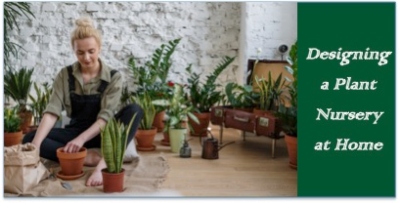How to Design a Thriving Plant Nursery at Home (Guest Blog)

Plants provide us with something beautiful to look at, delicious food, and a unique way to lower stress levels. Even if you don’t consider yourself to have a “green thumb,” it’s easy to design and nourish your own plant nursery at home. From a rooftop garden to some backyard agriculture, you can enjoy the many benefits that plants provide without ever having to leave your house. In this guide, you’ll discover some information and helpful tips to design a plant nursery at home to enjoy for years to come.
What is a Plant Nursery?
A plant nursery is where plants are grown from seed and cultivated and harvested once they reach a certain age. When designing one at home, the same general rules apply in terms of caring for and nurturing your plants. Even if you don’t have a large backyard, you can easily design your nursery with some simple tips. Large commercial nurseries grow plants for landscaping and decoration and sell them to vendors and retail stores. For a home nursery, you can cultivate various plants based on your region and climate, your ability to care for different plants, and how much room you have available. Even a rooftop garden can be a fantastic home nursery.
Types of Nurseries
There are several different types of nurseries, and the one you choose depends on the kind of plants you want to grow and the plant’s purpose. Here are some examples of plant nurseries to help you decide which one is best for you:
Fruit plant nursery. Grow and enjoy your own delicious fruits with a fruit plant nursery. Fruit needs lots of sunshine and warm temperatures to grow. You may need to learn about which types of fruit require other plants for them to produce a harvest. From citrus fruits like lemons and oranges to delicious cherries and apples, fruit typically grows on trees, shrubs, or vines.
Vegetable nursery. Try your hand at organic gardening with a vegetable nursery. You don’t need as much space to grow a vegetable nursery since most veggies grow low to the ground or underground, with a few exceptions. Make sure that you protect your vegetables from winter’s frost to keep them alive during the colder months of the year.
Ornamental plant nursery. Ornamental plants can be anything from flowers to succulents. Explore a range of ornamental plants that will thrive in your particular growing zone or plant hardiness zone to determine which ones are best for you. An ornamental plant nursery does well in a greenhouse, or you can even start a small one inside your home.
Medicinal and aromatic plant nursery. From healing herbs to delicious homegrown spices, a medicinal and aromatic plant nursery is an excellent choice if you enjoy cooking. Grow everything from basil to rosemary in your nursery, and you’ll never have to shop for these items again. You can also dry your herbs and spices to create homemade potpourri or a beautiful dried bouquet.
Forest plant nursery. If you want to contribute to the environment and have a lot of outdoor space, a forest plant nursery is a good choice. These plant nurseries tend to contain oak, pine, elm, and other trees that can be re-planted to help restore the forests. Some people grow pine trees on their property to sell during the holidays as Christmas trees, too.
How Much Space is Needed and Adjustments Required
It’s essential to make sure that you have plenty of room if you’re planning to design a plant nursery at home. Here is some information about the amount of space you’ll need and any adjustments that might be required before you start gardening:
Backyard. Measure the size of your yard and draw out how much space you plan to allocate for your plant nursery. Vegetables, ornamental plants, and herbs tend to take up less space than larger species like fruit or woodland trees. You’ll also need to check the soil to make sure that it’s fertile. Test the pH level of your soil and add some topsoil and fertilizer if necessary. It’s also a good idea to till the ground before you plant your seeds, so they have a healthy environment to grow their roots. Ensure you practice sustainable and eco-friendly pest control and growing methods to keep the plants and the environment safe.
Rooftop. If you live in an apartment or condo, a rooftop garden is a fun way to grow various plants. After you get permission from your landlord, fill several containers with soil and seeds, or add them to a raised garden bed. You don’t need as much space if you grow this type of plant nursery. However, vining plants are best since they don’t spread vertically, saving you valuable rooftop real estate. Your roof will get a lot of full sun, so make sure that your plants get adequate shade and plenty of water to keep them happy and healthy.
Basic Tools
Here are some essential tools you’ll need before you get started designing and cultivating your plant nursery:
- A quality pair of sharp pruning shears
- Durable gardening gloves
- Stakes to help support your plants as they grow and get strong
- Healthy soil and fertilizer or compost to nourish your plants
- Ground cover like netting or burlap to protect the earth and keep it warm
- Small trays and pots to start your seeds in
- A shovel, trowel, garden rake, and tiller to move dirt easily
- A high-quality garden hose and/or a sprinkler system
- Soil thermometer to check the temperature of the dirt
- Fencing or protective netting to keep large animals out of your nursery
Propagation Techniques
The term propagation refers to the creation of new plants from existing ones. There are two main types of propagation techniques: sexual and asexual. Sexual propagation uses the plant’s floral parts and requires the union of the pollen and the egg of the plants. This union gathers the genes from both plants together to create a new individual plant. With asexual propagation, you can simply take a cutting of the plant and place it in water until roots begin to form. Other methods of asexual propagation include grafting and budding. Some species of plants require sexual propagation to grow, while others don’t. Research your plants carefully to determine which method will work for your nursery.
Planning your nursery
Once you’re ready to start your nursery, it’s time to do a bit of advanced planning. First, determine exactly where you want to grow your nursery and make sure that the soil is ready to receive seeds. You may want to draw the layout on paper to give you a better idea of where things will go and how everything will look. Make sure you have everything on your primary tool and accessories checklist, and then you can begin the work of gardening.
Choose what to grow. The most important part of planning your nursery is choosing what you want to grow. Look at your plant hardiness zone and pick out plants based on the climate and the location of your nursery, as well as the size. Research a variety of species and choose plants that require low maintenance and are easiest to cultivate.
Planting the plants
Now it’s time to plant your seeds and watch your beautiful new plant nursery flourish. Here are some tips to help you grow plants from seeds and propagate your plants through cuttings.
Growing plants from seeds (how to sow): Different plants may need different conditions to grow from seed, but there are some basics you can follow to ensure success. Start your seeds indoors and place them in a seed tray or a variety of small cups or bowls. Use a seed starting mix to help encourage your seeds to grow faster and sprout roots. Moisten the seeds before you mix them so that they get just the right amount of water. Monitor the temperature and make sure that it’s within the appropriate range based on your specific seeds. Cover everything with a clear plastic lid and place them under a grow light until they’re ready to be relocated to the ground. Keep in mind that it can take six to eight weeks or longer for your seeds to start growing, so patience is key.
Propagation by cuttings: Once your plants grow to a healthy full size, you can propagate them via cuttings. Start with a cutting of about four to six inches long and cut them just where the leaf meets the stem using a sharp knife or pair of scissors. Remove any flowers and excess leaves, then place your cutting in a soil mix in a small container. You can dip the cutting in a plant growth hormone to encourage faster growth. Water your soil till damp, and then cover everything with a clear plastic bag to hold the heat and moisture in. Once the plant is large and strong, you can move it to a larger pot or add it to your garden.
Keep these tips in mind if you’re ready to design your own plant nursery at home. From an organic vegetable garden to ornamental flowers and shrubs, the possibilities are endless. With the right techniques and plenty of room, you’ll be able to grow and cultivate a beautiful nursery for many years to come. Still, if you have questions on how to grow and care for specific types of plants, ask the horticulturist you can find near you to get the best advice.
This Guest Post was contributed by Porch.com






